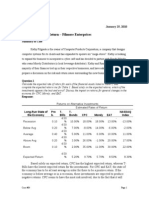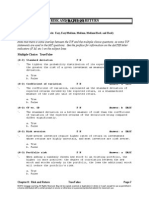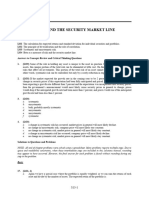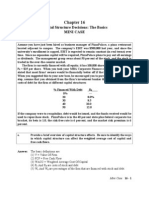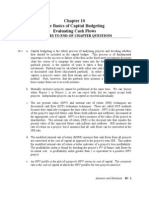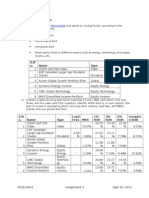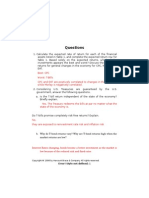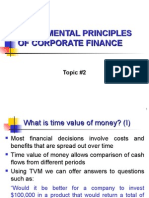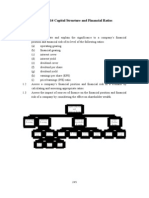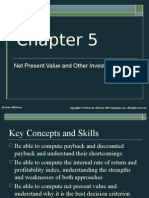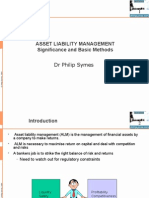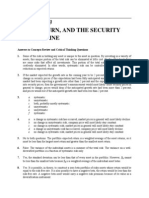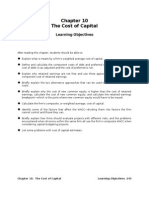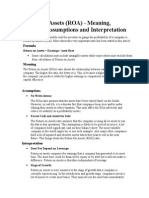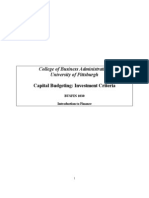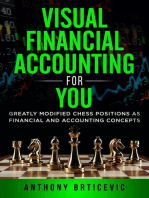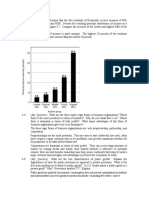Answers To Practice Questions: The Value of Common Stocks
Answers To Practice Questions: The Value of Common Stocks
Uploaded by
Andrea RobinsonCopyright:
Available Formats
Answers To Practice Questions: The Value of Common Stocks
Answers To Practice Questions: The Value of Common Stocks
Uploaded by
Andrea RobinsonOriginal Title
Copyright
Available Formats
Share this document
Did you find this document useful?
Is this content inappropriate?
Copyright:
Available Formats
Answers To Practice Questions: The Value of Common Stocks
Answers To Practice Questions: The Value of Common Stocks
Uploaded by
Andrea RobinsonCopyright:
Available Formats
CHAPTER 4
The Value of Common Stocks
Answers to Practice Questions
1. Newspaper exercise, answers will vary
2. The value of a share is the discounted value of all expected future dividends. Even
if the investor plans to hold a stock for only 5 years, for example, then, at the time
that the investor plans to sell the stock, it will be worth the discounted value of all
expected dividends from that point on. n fact, that is the value at which the
investor expects to sell the stock. Therefore, the present value of the stock today
is the present value of the expected dividend payments from years one throu!h
five plus the present value of the year five value of the stock. This latter amount
is the present value today of all expected dividend payments after year five.
". The market capitali#ation rate for a stock is the rate of return expected by the
investor. $ince all securities in an e%uivalent risk class must be priced to offer
the same expected return, the market capitali#ation rate must e%ual the
opportunity cost of capital of investin! in the stock.
&.
Expected 'uture (alues )resent (alues
*ori#on
)eriod
+*,
-ividend
+-(
t
,
)rice
+)
t
,
.umulative
-ividends
'uture
)rice Total
/ 1//.// 1//.// 1//.//
1 1/.// 1/5.// 0.1/ 21."/ 1//.//
2 1/.5/ 11/.25 13.3& 0"."3 1//.//
" 11./" 115.13 2".02 13.11 1//.//
& 11.50 121.55 "/.51 32.5/ 1//.//
1/ 15.51 132.02 52.1& &/.23 1//.//
2/ 25.21 235."" 0".12 13.21 1//.//
5/ 1/2.21 1,1&3.1& 20.2& 1./3 1//.//
1// 1,252."2 1",15/.1" 22.22 /./1 1//.//
4ssumptions
1. -ividends increase by 55 per year compounded.
2. The capitali#ation rate is 155.
21
5. a. 6sin! the !rowin! perpetuity formula, we have7
)
/
8 -iv
1
9+r : !,
1" 8 1.309+r ; /./05,
r 8 /.1/0 8 1/.05
b. <e know that7
)lowback ratio 8 1./ : payout ratio
)lowback ratio 8 1./ ; /.5 8 /.5
4nd, we also know that7
dividend !rowth rate 8 ! 8 plowback ratio =>E
! 8 /.5 /.12 8 /./3 8 3./5
6sin! this estimate of !, we have7
)
/
8 -iv
1
9+r : !,
1" 8 1.309+r ; /./3,
r 8 /./0" 8 0."5
3. 6sin! the !rowin! perpetuity formula, we have7
)
/
8 -iv
1
9+r : !, 8 29+/.12 ; /./&, 8 ?25
1. ?1//.//
/.1/
?1/
r
-(
)
1
4
?0".""
./& / /.1/
5
! r
-(
)
1
@
,
_
+ + + + + +
3
1
3
3
5
5
&
&
"
"
2
2
1
1
.
1.1/
1
/.1/
-(
1.1/
-(
1.1/
-(
1.1/
-(
1.1/
-(
1.1/
-(
1.1/
-(
)
?1/&.5/
1.1/
1
/.1/
12.&&
1.1/
12.&&
1.1/
1/."1
1.1/
0.3&
1.1/
1.2/
1.1/
3.//
1.1/
5.//
)
3 3 5 & " 2 1
.
,
_
+ + + + + +
4t a capitali#ation rate of 1/ percent, $tock . is the most valuable.
'or a capitali#ation rate of 1 percent, the calculations are similar. The results
are7
)
4
8 ?1&2.03
)
@
8 ?133.31
)
.
8 ?153.&0
20
Therefore, $tock @ is the most valuable.
0. a. <e know that !, the !rowth rate of dividends and earnin!s, is !iven by7
! 8 plowback ratio =>E
! 8 /.&/ /.2/ 8 /./0 8 0./5
<e know that7
r 8 +-(
1
9)
/
, A !
r 8 dividend yield A !rowth rate
Therefore7
r 8 /./& A /./0 8 /.12 8 12./5
b. -ividend yield 8 &5. Therefore7
-(
1
9)
/
8 /./&
-(
1
8 /./& )
/
4 plowback ratio of /.& implies a payout ratio of /.3, and hence7
-(
1
9E)$
1
8 /.3
-(
1
8 /.3 E)$
1
E%uatin! these two expressions for -(
1
!ives a relationship between
price and earnin!s per share7
/./& )
/
8 /.3 E)$
1
)
/
9E)$
1
8 15
4lso, we know that7
1
]
1
/ /
1
)
)(B>
1 r
)
E)$
<ith +)
/
9E)$
1
, 8 15 and r 8 /.12, the ratio of the present value of !rowth
opportunities to price is &&.& percent. Thus, if there are suddenly no
future investment opportunities, the stock price will decrease by &&.&
percent.
c. n )art +b,, all future investment opportunities are assumed to have a net
present value of #ero. f all future investment opportunities have a rate of
return e%ual to the capitali#ation rate, this is e%uivalent to the statement
that the net present value of these investment opportunities is #ero.
*ence, the impact on share price is the same as in )art +b,.
22
2. nternet exerciseC answers will vary dependin! on time period.
1/. nternet exerciseC answers will vary dependin! on time period.
11. 6sin! the concept that the price of a share of common stock is e%ual to the
present value of the future dividends, we have7
1
]
1
+
+
+
+
+
+
+
!, +r
-(
r, +1
1
r, +1
-(
r, +1
-(
r, +1
-(
)
&
" "
"
2
2 1
1
]
1
+
+
+
+
+
+
+
) 06 . 0 r (
) 06 . 1 3 (
) r 1 (
1
) r 1 (
3
) r 1 (
2
) r 1 (
1
50
3 3 2
6sin! trial and error, we find that r is approximately 11.1 percent.
12. There are two reasons why the correspondin! earnin!s;price ratios are not
accurate measures of the expected rates of return.
'irst, the expected rate of return is based on future expected earnin!sC the price;
earnin!s ratios reported in the press are based on past actual earnin!s. n
!eneral, these earnin!s fi!ures are different.
$econd, we know that7
1
]
1
/ /
1
)
)(B>
1 r
)
E)$
*ence, the earnin!s;price ratio is e%ual to the expected rate of return only if
)(B> is #ero.
1". a. 4n ncorrect 4pplication. *otshot $emiconductorDs earnin!s and
dividends have !rown by "/ percent per year since the firmDs foundin! ten
years a!o. .urrent stock price is ?1//, and next yearDs dividend is
proEected at ?1.25. Thus7
"1.255 ."125 / ."/ /
1//
1.25
!
)
-(
r
/
1
+ +
This is wrong because the formula assumes perpetual !rowthC it is not
possible for *otshot to !row at "/ percent per year forever.
"/
4 .orrect 4pplication. The formula mi!ht be correctly applied to the >ld
'aithful =ailroad, which has been !rowin! at a steady 5 percent rate for
decades. ts E)$
1
8 ?1/, -(
1
8 ?5, and )
/
8 ?1//. Thus7
1/./5 .1/ / ./5 /
1//
5
!
)
-(
r
/
1
+ +
Even here, you should be careful not to blindly proEect past !rowth into the
future. f >ld 'aithful hauls coal, an ener!y crisis could turn it into a
!rowth stock.
b. 4n ncorrect 4pplication. *otshot has current earnin!s of ?5.// per share.
Thus7
5./5 ./5 /
1//
5
)
E)$
r
/
1
This is too low to be realistic. The reason )
/
is so hi!h relative to earnin!s
is not that r is low, but rather that *otshot is endowed with valuable !rowth
opportunities. $uppose )(B> 8 ?3/7
)(B>
r
E)$
)
1
/
+
3/
r
5
1// +
Therefore, r 8 12.55
4 .orrect 4pplication. 6nfortunately, >ld 'aithful has run out of valuable
!rowth opportunities. $ince )(B> 8 /7
)(B>
r
E)$
)
1
/
+
/
r
1/
1// +
Therefore, r 8 1/./5
"1
1&.
! r
N)(
r
E)$
price $hare
1
+
Therefore7
/.15, +r
N)(
r
E)$
F
G G
1 G
G
+
/./0, +r
N)(
r
E)$
F
H
H
H
H1
H
+
The statement in the %uestion implies the followin!7
,
_
>
,
_
+
/.15, +r
N)(
r
E)$
/.15, +r
N)(
/./0, +r
N)(
r
E)$
/./0, +r
N)(
G
G
G
G1
G
G
H
H
H
H1
H
H
=earran!in!, we have7
1 1
EPS
r
) 08 . 0 r (
NPV
EPS
r
) 15 . 0 r (
NPV
<
a. N)(
I N)(
, everythin! else e%ual.
b. +r
; /.15, J +r
; /./0,, everythin! else e%ual.
c.
/./0, +r
N)(
/.15, +r
N)(
H
H
G
G
<
, everythin! else e%ual.
c.
H1
H
G1
G
E)$
r
E)$
r
<
, everythin! else e%ual.
15. a. Browth;TechDs stock price should be7
2".01
./0, / +/.12
1.2&
+1.12,
1
+1.12,
1.15
+1.12,
/.3/
+1.12,
/.5/
)
" " 2
$
,
_
+ + +
b. The hori#on value contributes7
?22./1
./0, / +/.12
1.2&
+1.12,
1
, )(+)
" *
"2
c. <ithout )(B>, )
"
would e%ual earnin!s for year & capitali#ed at
12 percent7
?2/.15
/.12
2.&2
Therefore7 )(B> 8 ?"1.// ; ?2/.15 8 ?1/.25
d. The )(B> of ?1/.25 is lost at year ". Therefore, the current stock price of
?2".01 will decline by7
?1."/
+1.12,
1/.25
"
The new stock price will be ?2".01 ; ?1."/ 8 ?13.51
13. nternet exerciseC answers will vary dependin! on time period.
11. nternet exerciseC answers will vary.
10. nternet exerciseC answers will vary.
12. a. *ere we can apply the standard !rowin! perpetuity formula with
-(
1
8 ?&, ! 8 /./& and )
/
8 ?1//7
0./5 ./0 / ./& /
1//
&
!
)
-(
r
/
1
+ +
The ?& dividend is 3/ percent of earnin!s. Thus7
E)$
1
8 &9/.3 8 ?3.31
4lso7
)(B>
r
E)$
)
1
/
+
)(B>
/./0
3.31
1// +
)(B> 8 ?13.3"
""
b. -(
1
will decrease to7 +/.2/ 3.31, 8 ?1.""
*owever, by plowin! back 0/ percent of earnin!s, .$ will !row by
0 percent per year for five years. Thus7
Kear 1 2 " & 5 3 1, 0 . . .
-(
t
1."" 1.&& 1.53 1.30 1.01 5.00 .ontinued
!rowth at
E)$
t
3.31 1.2/ 1.10 0.&/ 2./1 2.0/ & percent
Note that -(
3
increases sharply as the firm switches back to a 3/ percent
payout policy. 'orecasted stock price in year 5 is7
?1&1
./& / /./0
5.00
! r
-(
)
3
5
Therefore, .$Ds stock price will increase to7
?1/3.22
1./0
1&1 1.01
1./0
1.30
1./0
1.53
1./0
1.&&
1./0
1.""
)
5 & " 2
/
+
+ + + +
2/. 'ormulas for calculatin! )(+)
*
, include the followin!7
a.
)(+)
*
, 8 +E)$
*
9r, A )(B>
where E)$
*
is the firmDs earnin!s per share at the hori#on date.
+This formula would be the easiest to apply if )(B> 8 /.,
b.
)(+)
*
, 8 E)$
*
+)9E,
.
where +)9E,
.
is the )9E ratio for comparable firms.
+This formula would be a !ood choice if comparable firms can be readily
identified.,
c.
)(+)
*
, 8 @(
*
+L(9@(,
.
where @(
*
is the firmDs book value per share at the hori#on date, and
+L(9@(,
.
is the market;book ratio for comparable firms.
+This formula would be a !ood choice if comparable firms can be readily
identified.,
d.
)(+)
*
, 8 .
* A 1
9+r : !,
where .
* A 1
is the firmDs cash flow in the subse%uent time period.
+This formula would be a !ood choice if the assumption of !rowth at a
constant rate ! for the foreseeable future is a reasonable assumption.,
"&
21. a.
Kear
1 2 " & 5 3 1 0 2 1/
4sset value 1/.// 11.5/ 1".2" 15.21 11.&2 12.13 22."" 2".31 25./2 23.3/
Earnin!s 1.2/ 1."0 1.52 1.0" 2.1/ 2."1 2.30 2.0& "./1 ".2/
nvestment 1.5/ 1.1" 1.20 2.20 2.21 2.51 1."& 1.&2 1.51 1.3/
'ree cash flow ;/."/ ;/."5 ;/."2 ;/.&5 ;/.11 ;/.2/ 1."& 1.&2 1.5/ 1.3/
Earnin!s !rowth 2/./5 2/./5 2/./5 2/./5 2/./5 1"./5 1"./5 3./5 3./5 3./5
The present value of the near;term flows +i.e., years 1 throu!h 3, is ;?1."0
The present value of the hori#on value is7
?10.21
./3, / +/.1/
1."&
+1.1/,
1
, )(+)
3 *
Therefore, the present value of the free cash flows is7
+?10.21;?1."0, 8 ?11.5"
The present value of the near term cash flows increases because the
amount of investment each year decreases. *owever, the present value
of the hori#on value decreases by a !reater amount, so that the total
present value decreases.
b. <ith one million shares currently outstandin!, price per share is7
+?11.5" million91 million shares, 8 ?11.5"
The amount of financin! re%uired is ?1."0 million, so the number of shares
to be issued is7 +?1."0 million9?11.5", 8 12,/// shares +approximately,
c. +i, ?11.5" million91 million shares 8 ?11.5" per share
+ii, previously outstandin! shares9total shares 8
1 million91./12 million 8 /.2230
/.2230 ?10.21 8 ?11.5"
22. The value of the company increases from ?1// million to ?2// million.
The value of each share remains the same at ?1/.
"5
2".
Expected 'uture (alues )resent (alues
*ori#on
)eriod
+*,
-ividend
+-(
t
,
)rice
+)
t
,
.umulative
-ividends
'uture
)rice Total
/ 1//.// 1//.// 1//.//
1 15.// 1//.// 1"./& 03.23 1//.//
2 5.// 11/.// 13.02 0".10 1//.//
" 5.5/ 121.// 2/.&& 12.53 1//.//
& 3./5 1"".1/ 2".2/ 13.1/ 1//.//
1/ 1/.12 2"5.12 &1.12 50.20 1//.//
2/ 21.0/ 311.52 32.3" "1."1 1//.//
5/ &05./2 1/,311.2/ 2/.15 2.05 1//.//
1// 53,2&&.30 1,252,102.2& 20.2" 1./1 1//.//
n order to pay the extra dividend, the company needs to raise an extra ?1/ per
share in year 1. The new shareholders who provide this cash will demand a
dividends of ?/.5/ per share in year 2, ?/.55 in year ", and so on. Thus, each
old share will receive dividends of ?15 in year 1, +?5.5/ : ?/.5/, 8 ?5 in year 2,
+?3./5 : ?/.55, 8 ?5.5/ in year ", and so on. The present value of a share at
year 1 is computed as follows7
?1//.//
1.15
1
/.1/ ; /.15
?5
1.15
?15
)(
,
_
+
"3
Challenge Questions
1. There is somethin! of an inconsistency in )ractice Muestion 11 since the
dividends are !rowin! at a very hi!h rate initially. This hi!h !rowth rate su!!ests
the company is investin! heavily in its future. 'ree cash flow e%uals cash
!enerated net of all costs, taxes, and positive N)( investments. f investment
opportunities are abundant, free cash flow can be ne!ative when investment
outlays are lar!e. *ence, where do the funds to pay the increasin! dividends
come fromN
4t some point in time, competition is likely to drive =>E down to the cost of
e%uity, at which point investment will decrease and free cash flow will turn
positive.
2. 'rom the e%uation !iven in the problem, it follows that7
b =>E, 9 +r
b 1
=>E, +b r
b, +1 =>E
@()$
)
/
.onsider three cases7
=>E I r +)
/
9@()$, I 1
=>E 8 r +)
/
9@()$, 8 1
=>E J r +)
/
9@()$, J 1
Thus, as =>E increases, the price;to;book ratio also increases, and when =>E 8
r, price;to;book e%uals one.
". 4ssume the portfolio value !iven, ?1// million, is the value as of the end of the
first year. Then, assumin! constant !rowth, the value of the contract is !iven by
the first payment +/.5 percent of portfolio value, divided by +r : !,. 4lso7
r 8 dividend yield A !rowth rate
*ence7
r ; !rowth rate 8 dividend yield 8 /./5 8 5./5
Thus, the value of the contract, (, is7
million ?1/
/./5
million, +?1// /.//5
(
"1
You might also like
- Case #84 Risk and Rates of Return - Filmore EnterprisesDocument9 pagesCase #84 Risk and Rates of Return - Filmore Enterprises3happy3100% (5)
- Shapiro CHAPTER 5 SolutionsDocument11 pagesShapiro CHAPTER 5 Solutionsjimmy_chou13140% (1)
- TN15 Teletech Corporation 2005Document8 pagesTN15 Teletech Corporation 2005kirkland1234567890100% (2)
- Chap 013Document56 pagesChap 013saud1411100% (10)
- Risk and Rates of Return ExerciseDocument61 pagesRisk and Rates of Return ExerciseLee Wong100% (2)
- Shapiro CHAPTER 2 SolutionsDocument14 pagesShapiro CHAPTER 2 Solutionsjimmy_chou1314100% (1)
- BEC 0809 AICPA Newly Released QuestionsDocument22 pagesBEC 0809 AICPA Newly Released Questionsrajkrishna03100% (1)
- RW7eCh13 ADocument7 pagesRW7eCh13 AandimahonyNo ratings yet
- Suggested Answers: May 2005 Final Course: Group 1 Paper - 2: Management Accounting and Financial AnalysisDocument20 pagesSuggested Answers: May 2005 Final Course: Group 1 Paper - 2: Management Accounting and Financial AnalysisQueasy PrintNo ratings yet
- FM11 CH 16 Mini-Case Cap Structure DecDocument11 pagesFM11 CH 16 Mini-Case Cap Structure DecAndreea VladNo ratings yet
- Candidates Are Required To Give Their Answers in Their Own Words As Far As Practicable. The Figures in The Margin Indicate Full MarksDocument4 pagesCandidates Are Required To Give Their Answers in Their Own Words As Far As Practicable. The Figures in The Margin Indicate Full Marksrenutimilsena1439No ratings yet
- Revision Progress Test 1 - Investment Appraisal: Answer 1Document7 pagesRevision Progress Test 1 - Investment Appraisal: Answer 1samuel_dwumfourNo ratings yet
- CH 10 IMDocument46 pagesCH 10 IMAditya Achmad Narendra WhindracayaNo ratings yet
- Exam 1 KeyFinanceDocument7 pagesExam 1 KeyFinancepoojasoni06No ratings yet
- Sporting Goods Division:: RequiredDocument3 pagesSporting Goods Division:: RequiredAmy HurleyNo ratings yet
- Solution - Problems and Solutions Chap 10Document6 pagesSolution - Problems and Solutions Chap 10سارة الهاشميNo ratings yet
- Time Value of MoneyDocument23 pagesTime Value of Moneyaer14No ratings yet
- Revision 5 - Cost of Capital: Answer 1Document14 pagesRevision 5 - Cost of Capital: Answer 1samuel_dwumfourNo ratings yet
- Risk and Rates of ReturnDocument22 pagesRisk and Rates of ReturnJollybelleann MarcosNo ratings yet
- Case 06 - FinalDocument5 pagesCase 06 - FinallittlemissjaceyNo ratings yet
- Chapter 14 Capital Structure and Financial Ratios: Answer 1Document12 pagesChapter 14 Capital Structure and Financial Ratios: Answer 1samuel_dwumfourNo ratings yet
- Consolidated Financial Statements After Acquisition: Complete Equity Method On Books of InvestorDocument5 pagesConsolidated Financial Statements After Acquisition: Complete Equity Method On Books of Investorsalehin1969No ratings yet
- Portfolio Management Research AssignmentDocument13 pagesPortfolio Management Research AssignmentZubaidahNo ratings yet
- Assignment 3Document5 pagesAssignment 3aklank_218105No ratings yet
- An Introduction To Risk and Return-History of Financial Market ReturnsDocument10 pagesAn Introduction To Risk and Return-History of Financial Market ReturnsanisaNo ratings yet
- IFM Notes Full Rudramurthy SirDocument94 pagesIFM Notes Full Rudramurthy SirSachin PatilNo ratings yet
- Chapter 08Document18 pagesChapter 08Tam NguyenNo ratings yet
- 84 QuestionsDocument6 pages84 QuestionsSean RichardsonNo ratings yet
- Shapiro CHAPTER 2 SolutionsDocument14 pagesShapiro CHAPTER 2 SolutionsPradeep HemachandranNo ratings yet
- CH #2 & #6Document8 pagesCH #2 & #6Rizwan KhanNo ratings yet
- Answers To Practice Questions: Capital Budgeting and RiskDocument9 pagesAnswers To Practice Questions: Capital Budgeting and RiskAndrea RobinsonNo ratings yet
- HW3 SolDocument13 pagesHW3 SolTowweyBerezNo ratings yet
- ICF - Lecture 2 - Time Value of MoneyDocument46 pagesICF - Lecture 2 - Time Value of Moneyioana_doncaNo ratings yet
- Ch13 Current Liab and ContigenciesDocument46 pagesCh13 Current Liab and ContigenciesJane Masigan100% (1)
- Fubuki Case Assignment FINALDocument4 pagesFubuki Case Assignment FINALnowgamiNo ratings yet
- MBA711 - Answers To Book - Chapter 3Document17 pagesMBA711 - Answers To Book - Chapter 3noisomeNo ratings yet
- Selected Practice Questions From Chapters 6 - 8, FIN 335, With Dr. GrahamDocument28 pagesSelected Practice Questions From Chapters 6 - 8, FIN 335, With Dr. GrahamSaraNowakNo ratings yet
- Data Analysis and Interpretation: 1.stability RatiosDocument31 pagesData Analysis and Interpretation: 1.stability RatiosAnonymous nTxB1EPvNo ratings yet
- 40 Costing SummaryDocument21 pages40 Costing SummaryQueasy PrintNo ratings yet
- Principles of Finance Work BookDocument53 pagesPrinciples of Finance Work BookNicole MartinezNo ratings yet
- Chapter 14 Capital Structure and Financial Ratios: 1. ObjectivesDocument17 pagesChapter 14 Capital Structure and Financial Ratios: 1. Objectivessamuel_dwumfourNo ratings yet
- Liquidity Ratio 001Document4 pagesLiquidity Ratio 001Anurag SahrawatNo ratings yet
- Ratio Analysis On Dhaka BankDocument8 pagesRatio Analysis On Dhaka Banktoxictouch100% (1)
- Net Present Value and Other Investment Rules: Mcgraw-Hill/IrwinDocument34 pagesNet Present Value and Other Investment Rules: Mcgraw-Hill/Irwinveronica1085No ratings yet
- Asset Allocation (Sharpe)Document28 pagesAsset Allocation (Sharpe)mjvicunaNo ratings yet
- Alm Asset Liability MGDocument40 pagesAlm Asset Liability MGAamirx64No ratings yet
- ADM3352 - Final (Fall 2008)Document10 pagesADM3352 - Final (Fall 2008)Tony536No ratings yet
- Amity AssignmentDocument16 pagesAmity AssignmentAnkita SrivastavNo ratings yet
- Chapter 13Document15 pagesChapter 13runner4peaceNo ratings yet
- FM StudyguideDocument18 pagesFM StudyguideVipul SinghNo ratings yet
- Linear Programming Formulation Problems SolutionsDocument14 pagesLinear Programming Formulation Problems SolutionsNakkolopNo ratings yet
- Chapter 10Document22 pagesChapter 10hoalongkiemNo ratings yet
- Stock MarketDocument47 pagesStock MarketswastikNo ratings yet
- Return On Assets (ROA) - Meaning, Formula, Assumptions and InterpretationDocument4 pagesReturn On Assets (ROA) - Meaning, Formula, Assumptions and Interpretationakashds16No ratings yet
- CHAPTER 1: Quantitative Methods - Introduction: Series 66: Textbooks, Software & VideosDocument38 pagesCHAPTER 1: Quantitative Methods - Introduction: Series 66: Textbooks, Software & VideosLeeAnn MarieNo ratings yet
- Capital BudgetingDocument34 pagesCapital BudgetingHija S YangeNo ratings yet
- Chapter 6 Risk and ReturnDocument6 pagesChapter 6 Risk and Returnsheeraz_255650545No ratings yet
- Rental-Property Profits: A Financial Tool Kit for LandlordsFrom EverandRental-Property Profits: A Financial Tool Kit for LandlordsNo ratings yet
- Between Security Markets and Protection Rackets: Formations of Political OrderFrom EverandBetween Security Markets and Protection Rackets: Formations of Political OrderNo ratings yet
- Visual Financial Accounting for You: Greatly Modified Chess Positions as Financial and Accounting ConceptsFrom EverandVisual Financial Accounting for You: Greatly Modified Chess Positions as Financial and Accounting ConceptsNo ratings yet
- The Customs Tariff Act, 1975: EctionsDocument1,116 pagesThe Customs Tariff Act, 1975: EctionsAndrea RobinsonNo ratings yet
- 18eKeyQuestionAnswers Ch14Document2 pages18eKeyQuestionAnswers Ch14Andrea RobinsonNo ratings yet
- 18eKeyQuestionAnswers Ch21Document1 page18eKeyQuestionAnswers Ch21Andrea RobinsonNo ratings yet
- 18e Key Question Answers CH 4Document2 pages18e Key Question Answers CH 4Andrea RobinsonNo ratings yet
